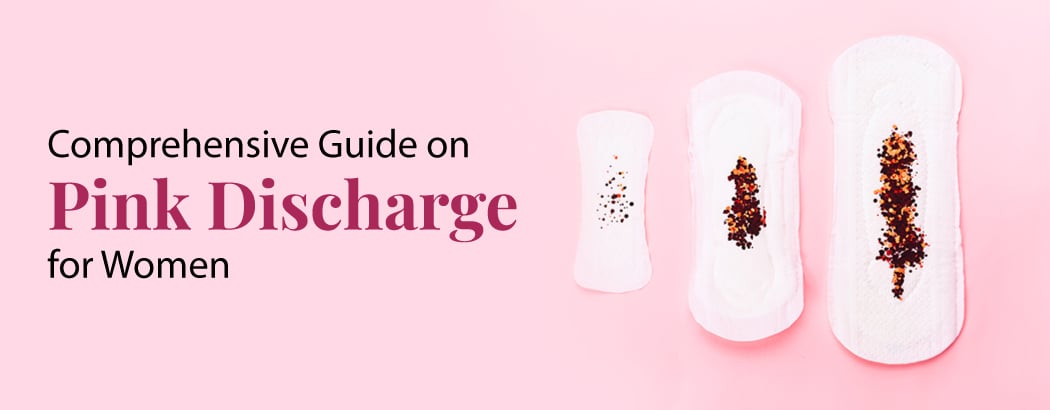Comprehensive Guide 0n Pink Discharge in Women
February 3, 2024

Pink Discharge
Pink-coloured vaginal discharge in females is just one of the many colours that might appear. It may manifest at several life stages, including menstruation, pregnancy, and sexual activity.
An infection or other medical condition may be indicated by pink discharge together with symptoms like discomfort or fever.
Contents
Normal Discharge
The cervix and vagina secrete mucus to get rid of old cells, bacteria, and dirt. This helps prevent infection. Regular hormonal oscillations that take place during the menstrual cycle might affect the texture, appearance, and volume of vaginal discharge.
Pink Discharge
Pink discharge is vaginal discharge with a pink or deeper red colour. Usually, fresh blood interacts with your regular vaginal discharge to cause a pink discharge. Pink discharge can have various origins, such as growths in your uterus, scrapes or tears in your vagina or cervix, and ulcers on your vulva. Pink discharge generally signifies the presence of implantation or other menstrual-related spotting, or it may indicate vaginal discomfort or cervical haemorrhage.
Common Causes of Pink Discharge
The most frequent causes of pink discharge are listed below:
- Normal period bleeding: Pink discharge may be seen at the beginning or end of your period, depending on the length of your cycle. There might be light to significant bleeding as the uterus sheds its lining. Lighter flow often appears pinker, particularly when combined with typical vaginal discharge.
- Light vaginal bleeding: The vagina has an abundant blood supply, which makes it possible for it to bleed readily at times. Even in the absence of pain, vaginal irritation from sexual activity, pelvic exams, or IUD insertions may result in transient, light bleeding. It appears pink when the blood mingles with the regular vaginal discharge.
- Implantation Bleeding: Women who become pregnant experience mild bleeding during the first trimester. Discharge with a pink or brown tint may resemble this.
- Abnormal menstrual cycles: If you have irregular periods as a result of perimenopause or polycystic ovarian syndrome (PCOS), you can see pink discharge rather than full flow at the scheduled time of your monthly cycle. At other points during your cycle, you could also see pink discharge.
- Breakthrough bleeding: Basically, breakthrough bleeding is any menstrual blood that appears while you’re not expecting a period. This can happen in reaction to emergency contraception or hormonal contraceptives. This kind of pink discharge is also seen in females who are smokers.
- Low oestrogen levels: The uterine lining thickens and gets ready for pregnancy with the help of oestrogen. The uterine lining becomes thicker and less stable as menopause approaches because oestrogen levels gradually decrease. Consequently, there may be sporadic spotting throughout the cycle. This discharge may have a brown, red, or pink appearance.
Serious Causes of Pink Discharge
Pink discharge could indicate a potentially dangerous condition that has to be checked out in certain situations:
- Ectopic pregnancy: This type of pregnancy arises when an egg that has been fertilised implants outside of the uterus, for example, in the fallopian tubes.
- STIs(sexually transmitted infections): STIs can result in vaginal, cervical, or uterine infections. Gonorrhoea and chlamydia are the most frequent causes. STI frequently result in painful urination, pain during sexual activity, foul-smelling discharge, or lower abdominal pain in addition to brown, pink, white, green, or clear discharge.
- Uterine fibroids: These benign growths may not show any symptoms at all, but if they do, vaginal discharge or mild bleeding is frequently an indicator.
- Miscarriages: Some pregnancies end up in miscarriages.The onset of symptoms in case of a miscarriage may be gradual or start as spotting or pink discharge.
- Cervical Cancer: A rare cause of pink discharge is cervical cancer.A typical early indicator of cervical cancer is pink vaginal discharge and irregular bleeding after sex and in between cycles.
Symptoms of Pink Discharge
Depending on the underlying reason, pink discharge might present with any of the following symptoms:
- A discharge that is lighter in colour and substance than a thick menstrual flow
- Cramping
- Soreness or discomfort
- A distinct smell
When should I see a Doctor about my Pink Discharge?
Pink discharge that appears occasionally is usually not a serious problem. When spotting or pink discharge occurs outside of the menstrual cycle and is accompanied by symptoms such as fever, pain, or dizziness, it is advisable to visit a healthcare practitioner in order to rule out infection or any other dangerous illness.
Even though it’s thought to be common in the early stages of pregnancy, pink discharge and spotting should be discussed with a healthcare provider.Seek prompt medical assistance in the event that you observe pink discharge in addition to:
- Blisters or blisters surrounding the vagina
- Discomfort in the abdomen or pelvis
- Fever
- Itching, swelling, or redness in the vaginal area
- Symptoms that seem to be growing worse
- Exposure to a sexually transmitted infection
After menopause, any bleeding or discharge should be examined by a medical professional.
Conclusion
Pink discharge throughout your menstrual cycle, during a sexual encounter, or during the beginning of a hormonal birth control treatment may be typical. This may happen when minute amounts of blood combine with transparent cervical fluid, giving the appearance of pinkness.
Frequently Asked Questions
1. Is a pink discharge common?
It may be typical to occasionally see pink discharge, depending on your situation. The causes can include early menstrual flow, perimenopause, or other hormonal changes.
2. How should you proceed if you wipe and notice pink discharge?
Pink discharge that fades after wiping is usually not a cause for concern and goes away in a few days, but it’s still vital to know when it starts, whether or not you have additional symptoms, and to always consult a medical professional if you’re unsure.
3. Do I need to get treatment for my pink discharge?
Pink discharge doesn’t always need to be treated. Pink discharge, for example, probably won’t need medical attention if it’s related to your monthly cycle, is a transient side effect of new birth control, or is during a period of life when hormones are shifting, such as perimenopause. A medical professional can advise on the necessity of treatment.







